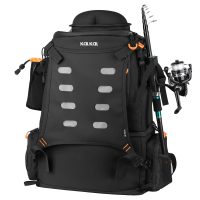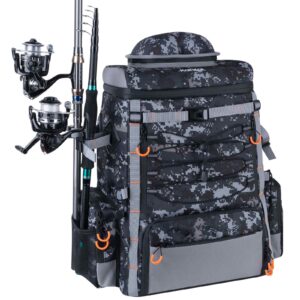Fishing is all about presentation, and sometimes even the most realistic bait needs a little something extra to entice those finicky fish. Enter the wacky rig setup, a unique pattern that takes your standard soft plastic bait and transforms it into an irresistible falling treat.
This blog will teach you about everything about wacky rigs, exploring what they are, why they’re effective, and how to set one up for ultimate fishing success.
We’ll also explore some wacky rig variations and when to use them compared to other popular techniques like the Neko rig. So, grab your rod and get ready to unlock the wacky world of bass fishing!
What Is a Wacky Rig?

A wacky rig is a fishing technique typically applied to soft plastics, especially in bass fishing as well as many other species fishing.
Unlike all the other rigging styles where the hook passes through the use of the end of the lure, in a wacky rig, the hook goes through the middle part of the body of the soft plastic bait.
This creates a specific action in which both ends of the lure mimic a slow, jerky fall through the water.
What Does Wacky Rig Imitate?
The jumping, shaking, twitching erratic movement of the wacky rig is specifically designed to imitate a worm that’s dying on the end of the hook or a lure fish bait that has sustained some injury or is incapacitated in some manner.
This can be particularly inviting bass for a couple of reasons.
- First, prey of a diseased substandard quality is easier to catch than a healthy one, making it easier for the bass.
- Second, the erratic movements can make a bass attack even if it has no food to consume; this is because the movements invoke the bass’s predatory nature.
- This is sometimes referred to as a “reaction strike.” Because of this, the wacky rig can be a great option when fish are suspicious of lures, or when they aren’t eating actively.
Why You Should Use a Wacky Rig?
Effective for Finicky Bass:
The wacky rig is especially great for slow-built bass, bass that fish a lot, or bass that are not interested in the speedy stuff. Its natural and wacky movement gives the appearance of an easy meal from which even the shyest bass cannot resist.
Simple Setup and Use:
Indeed, the wacky rig is among the simplest fishing rigs to rig up. All one requires is a fishing rod, a reel, a fishing line, a hook, and soft plastic bait. As such, it is suitable for first-time fishers or people who do not have the time or patience to fish extensively.
Versatile for Different Depths:
In turn, the wacky rig can be fished easily in water with varying depth levels. In cases of shallow water, a light and unweighted wacky rig will suffice. If the water is deeper, one can attach a small weight to the wacky rig by inserting a nail weight into the nose of the bait. This makes it possible to get the lure to the fish irrespective of their position on the water body.
How Effective Are Wacky Rigs?
These rigs are very productive particularly when targeting bass that are shy and pressured by baits or not hungry to feed. Here’s why:
Natural Presentation: The irregular undulating motion imitates a struggling worm or small baitfish, perfect for bass to gobble down.
Slow Fall: It has a slow sinking action to keep the bait in the strike zone longer, making all the bass that can be tempted just hold up.
Weedless Option: Can be fished weedless by putting on a weedless hook by rookies and catching those areas where some other lures could not access on account of their bulkiness.
What Fish Does It Attract To?
The unique rig mostly aims at bass, with most focus on both the largemouth and smallmouth variety of bass.
However, it is not limited to merely those species dwelling in freshwater, but may also be fed to other fish species that feed on worms or other small bait fish. These are fish like crappie, bluegills, sunfish or bass, walleye, perches, and even pickerel at certain times.
The secret which we don’t usually pay attention to is to tie your wacky rig to the size of the fish that you want to catch. For example, a small wacky rig using finesse worm – is suitable for crappies, whereas, a larger stick bait wacky rig – might be the best for big bass/walleye.
Different Types Of Wacky Rigs
There are a few variations on the classic wacky rig, each offering some advantages:
1. Unweighted Wacky Rig
This is the least Jewish and the most natural presentation which is great for shallow water where you want the extreme slow sinker and the most natural retrieve. It is ideal for fussy fish’s preferred habitat within a clear water environment.
2. Nail Weight Wacky Rig
If you have to probe for deeper water, a 2” strip of lead foil clipped to the line, or a small nail weight threaded into the ‘nose’ of the bait is advantageous since it helps to cast and sink the lure to the depth where bass are located. But don’t go overboard with the weight because you want the rig to sink slowly and erratically – that is how the wacky rig works best.
3. O-Ring Wacky Rig
An O-ring mounted in the shank of the hook has two functions. First, it keeps the soft plastic bait in place on the hook so it doesn’t slide up and down the shank with each cast and twitch. This is particularly beneficial when adjusting the baits of a slimmer design or somehow evoking that kind of haptic synthesis. Secondly, the O-ring applies a degree of pressure on the hook point and may make it easier to set the hook once a fish bites.
4. Double Wacky Rig
This variation increases the profile and size of the lure by employing two baits rigged wacky style on the same hook. This can be effective when you want to catch those big fish or when the bass is feeding more on larger meals. Nonetheless, it is crucial to know that the double wacky rig is more susceptible to snags on the vegetation. The size of the rig is not reasonable for clear aquatic environments where the finesse is more valuable.
Wacky Rig vs. Neko Rig: Pick Your Weapon
Both Wacky and Neko Rigs are finesse techniques for bass, but with some key differences:
- Hook Placement: Wacky rig – hook through the center of the bait. Neko rig – hook through the nose of the bait, with a small weight inserted into a slit in the bait’s body.
- Action: Wacky rig – erratic flutter. Neko rig – straight fall with a slight darting action from the weight.
- Best Use: Wacky rig – shallow water, pressured fish. Neko rig – deeper water, when fish want a slower fall with some erratic action.
How To Choose Between Them?
It is easy to decide which one should you use based on different fishing conditions:
- Shallow Water: Wacky rig
- Deeper Water: Neko rig
- Slow Erratic Fall: Wacky rig
- Slower Fall with some Darting Action: Neko rig
How To Set Up a Wacky Rig?
The wacky rig is another bass fishing technique that is regarded as interesting as well as one that is quite easy to apply. It is a style of fishing using a soft plastic bait – stick worm or Senko for instance – rigged in a manner that it falls slowly with unnatural movements that fish cannot resist. Here’s how to set up a wacky rig.
Equipment Required
- Rod: A medium-action spinning rod, 6’10” to 7′ in length, is ideal for feeling the subtle bites and providing good hooksets.
- Reel: A spinning reel spooled with a 10- to 12-pound fluorocarbon line offers a good balance of strength and sensitivity.
- Hook: A wacky hook is designed for this specific technique. It has a straight shank and a small eyelet positioned near the point. Size 1/0 to 2/0 is a good starting point.
- Soft plastic bait: Stick worms and Senkos are classic choices for wacky rigs. Choose a bait in the 4- to 6-inch range.
- O-rings (optional): These small rubber rings help keep the hook weedless and maintain the bait’s upright posture.
- Wacky rig tool (optional): This tool simplifies placing the O-rings on the bait.
Wacky Rig Setup Guide
- (Optional) Slide an O-ring onto your wacky rig tool (or spread open pliers).
- Push your soft plastic bait through the tool or O-ring on the pliers.
- Slide the O-ring up the bait to the center point. You can use a single O-ring or create an “X” with two O-rings for better weed resistance.
- Insert your wacky hook through the center of the bait, just below the O-ring(s). Don’t push the hook point all the way through.
Recommended Sizes
- Rod: 6’10” to 7′ medium-action spinning rod
- Hook: Wacky hook, size 1/0 to 2/0
- Line: 10- to 12-pound fluorocarbon line
- Soft plastic bait: 4- to 6-inch stick worm or Senko
How To Fish Wacky Rig?
Here are some useful tips when you go fishing with a wacky rig:
- Match the bait to the hatch: Choose a soft plastic worm or stick bait that mimics what the prey fish in your area are eating. Consider size, color, and action.
- Pick the right weight: A small nail weight is lighter, giving the bait a slower and more random descent which can be quite enticing to the fish. Allow visiting very shallow water, weightless condition.
- Target cover: Wacky rigs are perfect, especially in weeds, logs, docks, and other structures the fish like to hide in. The finesse presentation allows you to place the bait in areas that are difficult to reach.
- Fish with a weedless hook: This will help to ensure that your bait does not get stuck at every piece of cover, and therefore you can be able to fish productive areas without necessarily getting stuck.
- Vary your retrieve: Don’t stick to one type of retrieve all the time. Yoga example: This contains a slow and steady show, one must try twitching and a mix of both.
- Add scent (optional): Add any type of fish attractant to the bait you are going to use. This is particularly beneficial in murky waters as it can attract fish from a larger circumference.
Conclusion
Finesse fishing techniques are often termed as wacky, and the wacky rig is an easy method for fishing bass. It uses a soft plastic bait that is attached in the middle which makes it move in a twitching manner when falling.
Although simple to execute using elementary equipment, the wacky rig is excellent for use in shallow water or around cover; pressured fish cannot resist such naturally-flavored baits.
You need to consider using a wacky rig on your next bass fishing adventure!



















Leave a reply